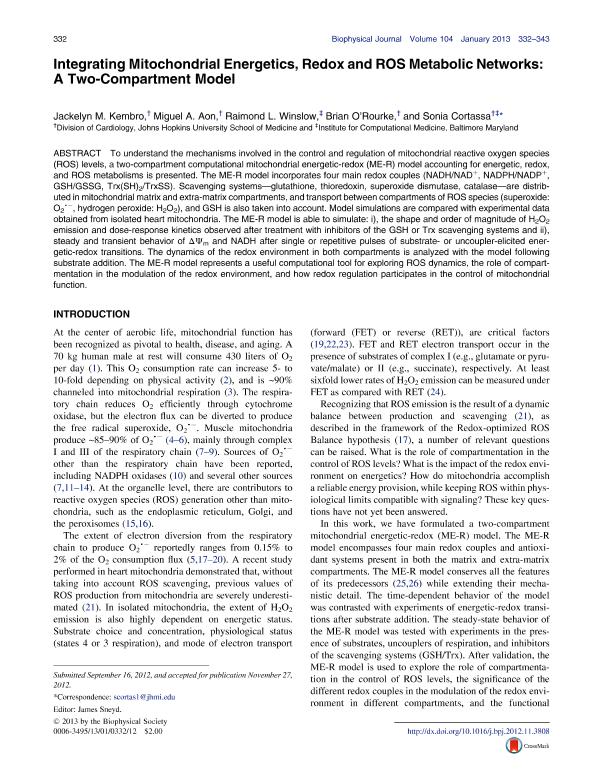Mostrar el registro sencillo del ítem
dc.contributor.author
Kembro, Jackelyn Melissa

dc.contributor.author
Aon, Miguel A.
dc.contributor.author
Winslow, Raimond L.
dc.contributor.author
O'Rourke, Brian
dc.contributor.author
Cortassa, Sonia del Carmen

dc.date.available
2017-09-22T17:47:13Z
dc.date.issued
2013-01
dc.identifier.citation
Kembro, Jackelyn Melissa; Aon, Miguel A.; Winslow, Raimond L.; O'Rourke, Brian; Cortassa, Sonia del Carmen; Integrating mitochondrial energetics, Redox and ROS metabolic networks: a two-compartment model; Elsevier; Biophysical Journal; 104; 2; 1-2013; 332-343
dc.identifier.issn
0006-3495
dc.identifier.uri
http://hdl.handle.net/11336/24945
dc.description.abstract
To understand the mechanisms involved in the control and regulation of mitochondrial reactive oxygen species (ROS) levels, a two-compartment computational mitochondrial energetic-redox (ME-R) model accounting for energetic, redox, and ROS metabolisms is presented. The ME-R model incorporates four main redox couples (NADH/NAD+, NADPH/NADP+, GSH/GSSG, Trx(SH)2/TrxSS). Scavenging systems—glutathione, thioredoxin, superoxide dismutase, catalase—are distributed in mitochondrial matrix and extra-matrix compartments, and transport between compartments of ROS species (superoxide: O2⋅−, hydrogen peroxide: H2O2), and GSH is also taken into account. Model simulations are compared with experimental data obtained from isolated heart mitochondria. The ME-R model is able to simulate: i), the shape and order of magnitude of H2O2 emission and dose-response kinetics observed after treatment with inhibitors of the GSH or Trx scavenging systems and ii), steady and transient behavior of ΔΨm and NADH after single or repetitive pulses of substrate- or uncoupler-elicited energetic-redox transitions. The dynamics of the redox environment in both compartments is analyzed with the model following substrate addition. The ME-R model represents a useful computational tool for exploring ROS dynamics, the role of compartmentation in the modulation of the redox environment, and how redox regulation participates in the control of mitochondrial function.
dc.format
application/pdf
dc.language.iso
eng
dc.publisher
Elsevier

dc.rights
info:eu-repo/semantics/openAccess
dc.rights.uri
https://creativecommons.org/licenses/by-nc-sa/2.5/ar/
dc.subject
Mitochondria
dc.subject
Redox Environment
dc.subject.classification
Bioquímica y Biología Molecular

dc.subject.classification
Ciencias Biológicas

dc.subject.classification
CIENCIAS NATURALES Y EXACTAS

dc.title
Integrating mitochondrial energetics, Redox and ROS metabolic networks: a two-compartment model
dc.type
info:eu-repo/semantics/article
dc.type
info:ar-repo/semantics/artículo
dc.type
info:eu-repo/semantics/publishedVersion
dc.date.updated
2017-08-09T14:25:45Z
dc.journal.volume
104
dc.journal.number
2
dc.journal.pagination
332-343
dc.journal.pais
Estados Unidos

dc.description.fil
Fil: Kembro, Jackelyn Melissa. University Johns Hopkins; Estados Unidos. Consejo Nacional de Investigaciones Científicas y Técnicas; Argentina
dc.description.fil
Fil: Aon, Miguel A.. University Johns Hopkins; Estados Unidos
dc.description.fil
Fil: Winslow, Raimond L.. Institute for Computational Medicine; Estados Unidos
dc.description.fil
Fil: O'Rourke, Brian. University Johns Hopkins; Estados Unidos
dc.description.fil
Fil: Cortassa, Sonia del Carmen. University Johns Hopkins; Estados Unidos. Institute for Computational Medicine; Estados Unidos. Consejo Nacional de Investigaciones Científicas y Técnicas; Argentina
dc.journal.title
Biophysical Journal

dc.relation.alternativeid
info:eu-repo/semantics/altIdentifier/doi/http://dx.doi.org/10.1016/j.bpj.2012.11.3808
dc.relation.alternativeid
info:eu-repo/semantics/altIdentifier/url/http://www.sciencedirect.com/science/article/pii/S0006349512050552
Archivos asociados
